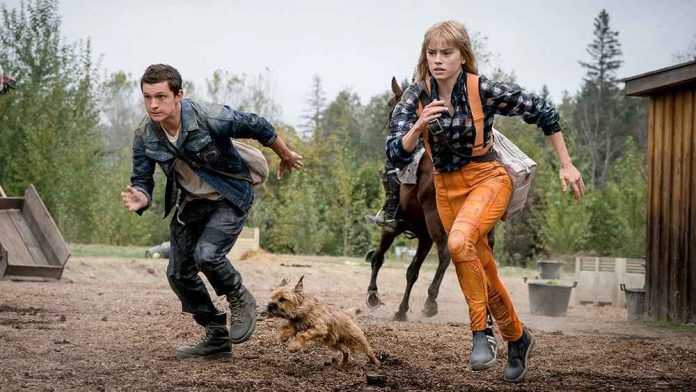Artnewspress: IGN serves a global audience, so with Chaos Walking out this week in theaters, we’re publishing our review from Tom Jorgensen who watched the film via a digital screener. Read more on IGN’s policy on movie reviews in light of COVID-19 here. IGN strongly encourages anyone considering going to a theater during the COVID-19 pandemic to check their local public health and safety guidelines before buying a ticket.
After more than a decade of steady Y.A. film adaptation releases, it takes more and more to stand apart from the pack. These days, you need a knockout cast, a talented director, critically praised source material, and a really interesting central conceit just to stand a chance. Chaos Walking, directed by Doug Liman (Edge of Tomorrow, The Bourne Identity), has those components in place, but never really manages to find a way to consistently make them work towards telling an interesting story.Chaos Walking adapts the first novel in Patrick Ness’ series of the same name (Ness co-wrote the script, too) and centers on Todd Hewitt (Tom Holland), a teen raised on the colony planet New World. Living on this alien planet comes with one hell of a caveat if you’re male: men on New World become afflicted by Noise, a condition which externally manifests their every thought for all to see and hear. Some men are able to channel their thoughts/Noise into flashy mirages and Todd’s showing promise in this regard. Only the dastardly Mayor Prentiss (Mads Mikkelsen) is able to completely control his Noise, even suppress it at will, and he uses that advantage to exert absolute authority over New World’s seemingly lone settlement, Prentisstown.
While Todd is mostly in the Mayor’s good graces, things change when Viola (Daisy Ridley), a scout for the next wave of New World settlers, crashes in the jungle. Having never met a girl before, Todd decides to risk his life for this one and go on a journey to help Viola make contact with her crew. And yes, the fact that Todd has both never been around a girl before and is unable to keep his thoughts from loudly tumbling out into the world both present a number of issues for their burgeoning relationship.
For those who haven’t read Ness’ novels, the big draw will be Tom Holland and Daisy Ridley leading the cast. With Chaos Walking having filmed just after Holland and Ridley’s big breaks as Marvel’s Peter Parker and Star Wars’ Rey, respectively, it’s clear that Kevin Feige and J.J. Abrams knew how to play off their strengths better than the filmmakers here did. Neither Holland’s charm or Ridley’s intensity get much chance to shine. Instead, Holland and Ridley play things incredibly straight for the most part. The pair do come to life a little more when Ness and co-writer Christopher Ford’s script calls for comedy, but these moments are few and far between in Chaos Walking. Considering she’s (almost) the only female character, Viola in particular feels woefully underdrawn. Todd spends a lot more time lamenting that he can’t hear Viola’s thoughts than actually asking her what she’s thinking, so by the time the movie gets around to its ho-hum conclusion, it feels like we barely know one of our leads.
Chaos Walking hangs a lot of its hopes on the sci-fi hook at its story’s center, but it’s a burden too heavy for the Noise to bear. In the film’s first act, much time is spent showing the audience how the Noise affects everyday life in Prentisstown, chiefly through Todd’s racing teen brain as he analyzes the world around him. The staccato, base observations that Todd’s Noise make border on “I love lamp” levels of cognitive depth and grow old quickly. The constant barrage of Noise borders on disorienting early on, which ironically undermines key demonstrations about how the Noise works, like when Todd uses it to conjure a snake to scare his rival. Once Daisy Ridley’s Viola enters the picture and separates Todd from the chaos in Prentisstown, the Noise becomes far more palatable. It’s creatively used to show Todd imagining himself catching Viola during a chase scene and to good comedic effect in an intimate moment between the two.
The occasional clever gag aside, the Noise too often feels unbound by rules or consistency. There are lots of times when you don’t hear a character’s Noise (especially a character who isn’t Todd) when it feels like you should and it stretches credulity that men so used to Noise as a daily part of life could be so easily tricked by others using it against them. None of this is helped by the less-than-stellar visual effects that bring the aurora-like Noise to life, especially noticeable when the thoughts depicted involve footage of actors composited into the colorful haze surrounding men’s heads.
Worst of all, the Noise is rarely used effectively in furthering Chaos Walking’s story or themes. It’s clear that the movie has things like personal autonomy and toxic masculinity on its mind, but because Viola stands as the only character in the movie not used to the Noise and she’s preoccupied with her mission, Chaos Walking rarely finds a reason to stop and have in-depth discussions on those topics. Liman seems content moving on to the next chase scene or fight rather than stopping to explore what Todd’s Noise urging him not to cry because it makes him less of a man means for the character.
Despite Liman’s impressive action pedigree, none of those action beats have much of a pulse. It’s perhaps Chaos Walking’s worst miscalculation: the potential of the Noise as a narrative device ends up being a lot more interesting than the formulaic plot and action scenes that relegate it to window dressing. It’s not the only underdeveloped element of the plot: there’s an entire native race implicated in the deaths of Prentisstown’s women called THE SPACKLE (emphasis mine) that are represented on-screen during only one scene and with only one… Spackler? Spack? Or is this a “deer” situation and it just stays “Spackle” for a single alien? Chaos Walking tends to breeze past answers to crucial questions like these.
David Oyelowo, Cynthia Erivo, Demián Bichir, and Nick Jonas round out the supporting roster. There’s a definite sense that everyone’s trying to make their parts work but, aside from Mikkelsen’s Prentiss and Oyelowo’s entertaining (if not very subtle) fire and brimstone preacher Aaron, the script doesn’t give the rest of the cast many memorable moments. Nick Jonas’ David Prentiss Jr. is set up as a rival to Todd early on, but he’s almost entirely forgotten by the end.
Verdict
Chaos Walking doesn’t do nearly enough to take advantage of its talented cast or the thematically ripe Noise which plagues the men of its world. Tom Holland and Daisy Ridley could have been a compelling duo, but they aren’t supported by a creative team that can get on the same page about what the focus of the movie should be. With its charms few and far between, Chaos Walking is a tough sell, especially considering the cast’s significantly increased clout in the years since it was first filmed means getting the gang back together for the implied sequel will be next to impossible. Fans of the novels may be better off waiting for the inevitable reboot. Maybe if you make enough Noise, HBO will pull a His Dark Materials and take another crack at it someday.























![‘The Feast’ Review: Mother Nature Bites Back in This Bloody Horror Movie [SXSW 2021]](https://artnewspress.com/en/wp-content/uploads/2021/03/The-Feast-Review-100x70.jpg)
